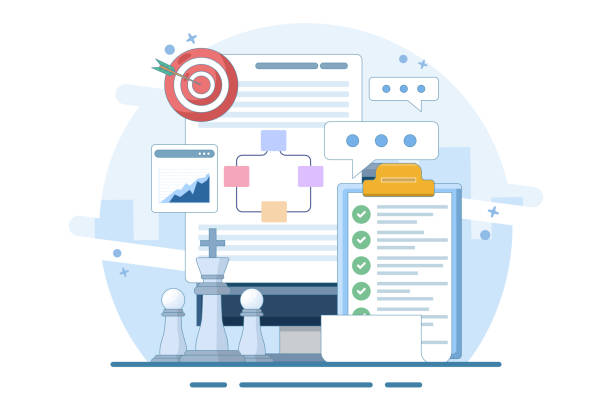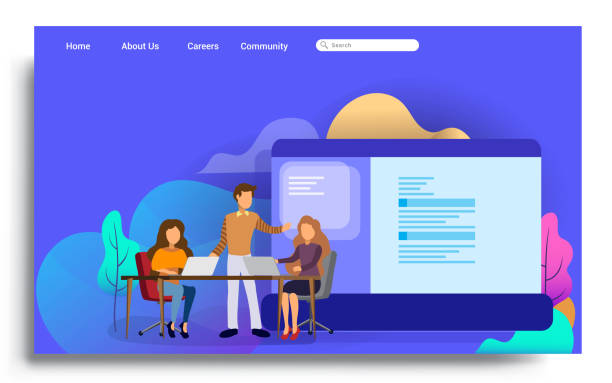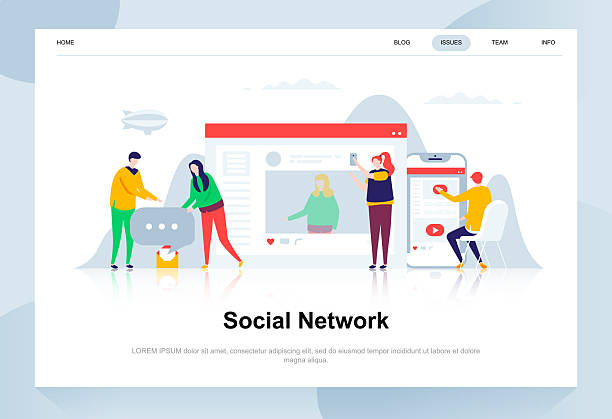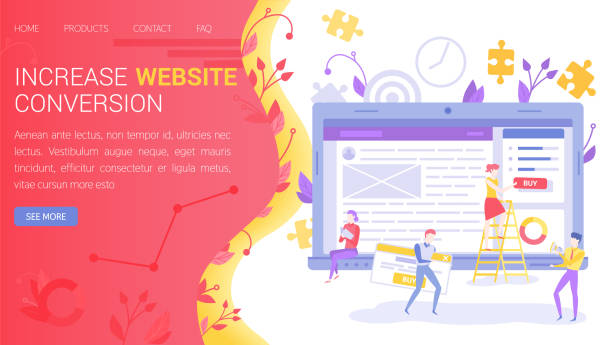Introduction to Secure Website Design and Its Importance in Today’s World

In the current digital age, where an online presence has become vital for every business and individual, secure website design is no longer an option, but an undeniable necessity.
#Website_security is not just about protecting user information; it also includes maintaining your brand’s credibility and trust.
An insecure website can be an easy target for hackers and malware, leading to the theft of sensitive information, Denial-of-Service (DDoS) attacks, or even the complete destruction of your online reputation.
With the increasing cyber threats, businesses and developers must adopt a proactive approach to security.
This approach means integrating security considerations from the very early stages of design and development, rather than considering it as an afterthought.
Creating a secure website involves a set of processes, tools, and best practices aimed at identifying, preventing, and mitigating vulnerabilities.
From data encryption to user access management and regular updates, every component of a website must be designed with security in mind.
Neglecting any of these can lead to security gaps with irreparable financial and reputational consequences.
Therefore, education and awareness in the principles of secure website design are crucial for all stakeholders, from managers to technical teams.
This explanatory and educational section provides the foundation for our understanding of this complex topic and emphasizes the importance of a comprehensive security approach in all stages of web development.
Cybersecurity is a broad concept, of which secure website design is an important part.
The ultimate goal is for users to be able to use online services with peace of mind and for their information to remain in a completely protected environment.
Did you know that customers’ first impression of your company is your website? With a powerful corporate website from Rasaw, multiply your business’s credibility!
✅ Custom and eye-catching design tailored to your brand
✅ Improved user experience and increased customer attraction
⚡ Get a free consultation!
Common Website Security Threats and Ways to Combat Them

Websites are constantly exposed to various #cyber_attacks that can compromise information, disrupt site performance, and damage business reputation.
Understanding these threats is the first step in secure website design and building a strong defense.
One of the most common attacks is SQL Injection, where an attacker injects malicious SQL code into the site’s inputs to manipulate the database.
To counter this attack, using Prepared Statements and input validation is essential.
Another threat is Cross-Site Scripting (XSS) attacks.
In this type of attack, malicious JavaScript code is injected into the website and executed in the victim’s browser, which can lead to cookie theft or alteration of page content.
Filtering and escaping user inputs, as well as using a Content Security Policy (CSP), are effective ways to counter XSS.
Cross-Site Request Forgery (CSRF) attacks also allow an attacker to send forged requests on behalf of the authenticated user.
Using CSRF tokens and verifying the request’s origin (Referrer) are solutions to prevent these types of attacks.
In addition to these, Denial-of-Service (DDoS) attacks render the website inaccessible by sending a huge volume of traffic to the server.
Using CDNs (Content Delivery Networks) and DDoS protection services can be effective against these attacks.
Secure website design must include planning to combat each of these threats.
This analytical and educational section helps you take the necessary steps to protect your website with a deeper understanding of vulnerabilities.
Never forget that security is an ongoing process, and as new threats emerge, security solutions must also be constantly updated.
Cyber attacks come in various forms, and understanding them is crucial for secure web design.
Principles of Secure Design in Website Backend and Frontend

Secure website design requires special attention to both the frontend (client-side) and backend (server-side).
Security in these two parts complements each other, and neglecting either can make the entire system vulnerable.
#Frontend_security focuses more on protecting users from client-side attacks such as XSS and Clickjacking.
Using client-side input validation (as a first layer of defense, not the only layer), implementing Content Security Policy (CSP) to control resources the browser can load, and using HTTPS protocol for encrypting communications are among the important principles in frontend.
Also, careful cookie management (using HttpOnly and Secure flags) and preventing sensitive information from being stored in the browser’s localStorage contribute to increased security.
On the other hand, #backend_security involves protecting the server, database, and business logic from direct attacks.
This includes implementing strong authentication and authorization, using reputable security frameworks with built-in security features, and ensuring APIs are secure.
Preventing SQL Injection using Prepared Statements, protecting against Path Traversal by restricting access to files and folders, and strict and thorough validation of all user inputs on the server-side are vital measures.
Also, managing errors in a way that sensitive system information is not disclosed, and maintaining security logs to track suspicious activities, are an important part of secure website design in the backend.
This specialized and guiding section demonstrates the importance of a comprehensive approach.
Both frontend and backend must work in harmony to create a strong defense.
Below is a comparative table of security approaches in frontend and backend that helps to better understand this topic:
| Feature | Frontend Security (Client-side) | Backend Security (Server-side) |
|---|---|---|
| Main Goal | Protecting the user from client-side attacks (XSS, Clickjacking) and increasing trust | Protecting the server, database, and business logic (SQL Injection, DoS, Data Breach) |
| Key Techniques | Initial input validation, CSP, HTTPS, cookie management, DOM filtering | Final input validation, Prepared Statements, strong authentication and authorization, error handling, logging |
| Common Vulnerabilities | XSS, CSRF (in some cases), Clickjacking, Content Spoofing | SQL Injection, Path Traversal, Remote Code Execution, Broken Authentication, Data Exposure |
| Role in Secure Website Design | Increasing resistance against client-side manipulations and enhancing user trust | Protecting data, business logic, and service stability |
The Role of SSL/TLS Certificates in Site Security and Trust Building

One of the main pillars in secure website design is the implementation of SSL/TLS certificates.
These certificates enable the HTTPS protocol, which encrypts communication between the user’s browser and the website server.
#Data_encryption means that exchanged information – including login credentials, credit card details, and personal data – becomes unreadable and tamper-proof during transit.
Without HTTPS, data is transmitted in plain text and can be easily intercepted and stolen by attackers.
Using SSL/TLS not only enhances security but also plays a very important role in building trust.
Users, by seeing the green padlock or “HTTPS” in the browser’s address bar, are assured that they are in a secure environment and can confidently enter their information.
This trust is vital for online businesses and e-commerce websites.
Furthermore, search engines like Google prefer websites with HTTPS in their search results rankings.
This means website security directly impacts your SEO and website visibility.
There are various types of SSL/TLS certificates, including Domain Validation (DV), Organization Validation (OV), and Extended Validation (EV).
Each of these certificates offers a different level of identity verification, with EV certificates providing the highest level of trust.
The choice of certificate type depends on the type of website and the sensitivity of the information exchanged on it.
This explanatory and specialized section emphasizes the necessity and multifaceted benefits of implementing these protocols in every modern secure website design.
Implementing SSL/TLS is a fundamental step towards protecting users and data, and ultimately online success.
HTTPS protocol is increasingly recognized as a standard for web security.
Does your current corporate website present a worthy image of your brand and attract new customers?
If not, turn this challenge into an opportunity with Rasaw’s professional corporate website design services.
✅ Significantly improves your brand’s credibility and image.
✅ Paves the way for attracting new leads and customers for you.
⚡ Contact Rasaw now for a free and expert consultation!
Website Database Security: The Most Important Layer of Information Protection

The beating heart of every website is its #database, where all vital information, from user data and orders to site content and settings, is stored.
Therefore, secure website design is meaningless without ensuring database security.
Database attacks, such as SQL injection or unauthorized access, can lead to the disclosure of sensitive information, data corruption, or even complete service unavailability.
The first step is strict input validation.
All data entered by the user must be thoroughly checked and sanitized to prevent the injection of malicious code.
Using Prepared Statements or ORMs (Object-Relational Mappers) that automatically prevent SQL injection is highly recommended.
The second layer is #data_encryption; sensitive information such as passwords, credit card numbers, or Personally Identifiable Information (PII) must be encrypted before being stored in the database.
Even if an attacker gains access to the database, without the decryption key, the data will be useless to them.
Third, managing user access to the database is crucial.
Every user or service with database access should only have the minimum necessary privileges to perform their tasks (Principle of Least Privilege).
Never use a “root” or “admin” account with full access for normal application connections.
Fourth, regular database backups and storing them in a secure, separate location are essential to enable data recovery in case of an attack or system failure.
This specialized and guiding section highlights the importance of deep attention to database security within the framework of a sustainable secure website design.
Database is the backbone of any web application.
Identity and User Authentication Management: The Key to Entering a Secure World

In any website that requires user interaction, user identity and authentication management is one of the most vital aspects of secure website design.
#Authentication is the process of verifying a user’s identity, while Authorization determines what resources the authenticated user can access.
A weak authentication system can be a major entry point for attackers.
To design a strong authentication system, first, strong passwords and their secure storage must be ensured.
Passwords should never be stored in plain text; instead, they should be hashed using strong hashing algorithms along with a “salt”.
Enforcing password policies such as minimum length, use of uppercase and lowercase letters, numbers, and special characters, helps to increase password strength.
Furthermore, preventing Brute Force attacks by limiting the number of unsuccessful login attempts and temporarily blocking suspicious accounts is essential.
Implementing Two-Factor Authentication (2FA) or Multi-Factor Authentication (MFA) is highly recommended.
2FA adds another layer of security that protects the user’s account even if the password is compromised.
This can be done through sending a code to a mobile phone, using authentication applications, or hardware keys.
Also, Session Management is very important.
Sessions should have a defined lifespan, expire after user inactivity, and their validity should be re-checked if the user’s IP address or Agent changes.
This explanatory and educational section emphasizes the importance of a comprehensive approach to the user login and access process.
A truly secure website design includes ensuring that only authorized users can access specific information and functionalities, and this is achieved by strongly implementing identity and authentication management systems.
Multi-factor authentication is an essential security method.
Updates and Security Patches: Why Are They Essential? A Guide to Secure Site Maintenance

One of the simplest yet most vital aspects of secure website design and its maintenance is ensuring regular updates of all software used.
#Security_updates not only add new features but, more importantly, address known security vulnerabilities that attackers can exploit.
Hackers are constantly searching for these weaknesses in older software versions.
This includes all layers of the website infrastructure: server operating system (e.g., Linux or Windows Server), web server software (e.g., Apache or Nginx), programming languages (e.g., PHP, Python, Node.js), frameworks and libraries, Content Management System (CMS) like WordPress or Joomla, and all plugins and themes installed on the CMS.
Any outdated and unpatched component can be a gateway for attackers to enter your system.
Tracking security news and notifications regarding new vulnerabilities (CVEs) and the availability of security patches for the software used is an important part of this process.
There should be a regular plan for applying these updates, preferably in a test environment (Staging Environment) before applying them to the live environment (Production Environment), to prevent potential problems after updating.
This news and guide section emphasizes that website security is not a static process, but requires continuous attention and maintenance.
Failure to adhere to this principle can quickly turn an initial secure website design into a vulnerable target.
Below is a table showing the importance of updating various website components:
| Website Component | Importance of Updates | Risk of Non-Update |
|---|---|---|
| Server Operating System | Fixing fundamental system-level vulnerabilities, increasing stability | Root access, DDoS attacks, entire server compromise |
| Web Server (Apache, Nginx) | Performance improvement, bug fixes and protocol security holes | Information disclosure, injection attacks, Denial of Service |
| Programming Language and Framework | Support for new security features, patching base code vulnerabilities | Remote Code Execution, logical vulnerabilities, Data Breach |
| Content Management System (CMS) | Fixing common platform vulnerabilities, improving core security | Site hacking, malicious code injection, user data disclosure |
| Plugins and Themes | Fixing specific vulnerabilities, ensuring compatibility with CMS core | Backdoor, webshell injection, API key disclosure |
Penetration Testing and Periodic Security Reviews to Detect Vulnerabilities

Even with the best secure website design approaches and strict adherence to all recommendations, the likelihood of a security incident is still not zero.
Therefore, having a comprehensive and ready #incident_response_plan (Incident Response Plan) is crucial for any organization and website that values its security.
This plan not only helps mitigate damages from an attack but also minimizes recovery time and ensures that the business can quickly return to normal.
These tests can include Black-Box Testing, where the pentester starts with no information about the system, similar to an external attacker.
Or they can be White-Box Testing, where the pentester is given full access to the source code and system information to comprehensively discover vulnerabilities.
The main goal of #penetration_testing is to identify weaknesses in configuration, business logic, coding, and infrastructure.
In addition to penetration testing, performing regular vulnerability scans using automated tools is also essential.
These scans can be run frequently and quickly identify known vulnerabilities.
Although these tools do not replace human pentesting, they provide a good initial layer for detecting obvious problems.
Reports from these tests and scans must be carefully reviewed, and the development team must take responsibility for fixing the discovered vulnerabilities.
Secure website design is an ongoing process, and these periodic inspections ensure that your website remains resilient against new threats.
This specialized and educational section emphasizes a proactive and continuous approach to maintaining website security.
Penetration testing is a vital method for discovering weaknesses.
Research shows that 80% of customers trust companies with professional websites more. Does your current site gain this trust?
With Rasaw’s professional corporate website design services, solve the problem of customer distrust and a weak online image forever!
✅ Create a professional image and increase customer trust
✅ Attract more sales leads and business growth
⚡ Get a free consultation
Incident Response and Data Recovery: Survival Strategy in Crisis

Even with the best secure website design approaches and strict adherence to all recommendations, the likelihood of a security incident is still not zero.
Therefore, having a #plan_for_security_incidents (Incident Response Plan) comprehensive and ready, is crucial for any organization and website that values its security.
This plan not only helps mitigate damages from an attack but also minimizes recovery time and ensures that the business can quickly return to normal.
An incident response plan includes several key stages: Preparation, which includes training teams, documenting procedures, and creating necessary tools.
Identification, which means quickly discovering the incident and assessing its impact.
Containment, which involves isolating infected systems to prevent the attack from spreading.
Eradication, which means completely removing the threat and eliminating vulnerabilities.
Recovery, which involves restoring systems and data to a secure operational state.
And finally, Lessons Learned, which is performed after each incident to improve future security processes.
An important part of data recovery is having #regular_and_reliable_backups.
Backups should be stored offline or in a separate, secure location to be accessible in case of an attack on the main system.
Testing the recovery process is as important as the backup itself.
This guiding and thought-provoking section reminds you that security is not just about prevention, but also about preparing for worst-case scenarios and effectively managing them.
A truly secure website design includes planning for when things don’t go perfectly.
Disaster recovery is a broader concept of which incident response is a part.
The Future of Secure Website Design and Emerging Trends in Web Security

The world of cybersecurity is constantly evolving, and with the emergence of new technologies, threats and solutions for secure website design also change.
To stay at the forefront of this battle, awareness of #emerging_trends in web security is essential.
One such trend is the increasing use of Artificial Intelligence (AI) and Machine Learning (ML) in security systems.
AI can identify suspicious traffic patterns, analyze malware, and even automatically respond to attacks, which significantly increases defensive efficiency.
#Serverless_Architecture is also growing, which can have its own security benefits, as the responsibility for server infrastructure management shifts to the cloud service provider, allowing the development team to focus more on the security of their code.
However, this architecture also brings new security challenges, such as managing Function Permissions and protecting temporary data.
Furthermore, data privacy is becoming a more central issue, with regulations like GDPR and CCPA forcing companies to adhere to stricter standards for protecting users’ personal information.
This directly impacts secure website design, as developers must consider “Privacy by Design” principles from the outset.
Also, Blockchain technology and its applications in increasing transparency and security of transactions and authentication show great potential.
This analytical and engaging section leads us towards the future of web security and shows us how new technologies can help in stronger defense against threats and highlights the need for a proactive approach in secure website design more than ever.
Preparing for these trends will be key to success in the future digital ecosystem.
Artificial Intelligence and Blockchain are two technologies shaping the future of security.
Frequently Asked Questions
| Row | Question | Answer |
|---|---|---|
| 1 | What is secure website design? | The process of designing and developing websites that are resistant to cyber attacks and protect user data and privacy. |
| 2 | Why is website security important? | To prevent data breaches, financial losses, damage to company reputation, and maintain user trust. |
| 3 | What are some common website security threats? | SQL Injection, XSS (Cross-Site Scripting), CSRF (Cross-Site Request Forgery), weak authentication, and unpatched software. |
| 4 | What is SSL/TLS and what is its role? | Protocols for encrypting data between the user’s browser and the website server, which ensures secure and private communication. |
| 5 | How can SQL Injection attacks be prevented? | By using Prepared Statements/Parameterized Queries, input validation, and ORMs (Object-Relational Mappers). |
| 6 | What is the role of a Web Application Firewall (WAF) in security? | WAF monitors and filters HTTP traffic between a web application and the internet to prevent malicious attacks. |
| 7 | Why is regular updating of software and libraries essential? | Updates include patches for known security vulnerabilities that attackers can exploit. |
| 8 | How can XSS attacks be prevented? | By sanitizing (Sanitizing) and escaping (Escaping) all user inputs before displaying them on the web page and using Content Security Policy (CSP). |
| 9 | What does the Principle of Least Privilege mean? | It means that users and systems are granted only the minimum necessary permissions to perform their tasks, preventing unnecessary access to resources. |
| 10 | What is the importance of proper Session Management? | To prevent session hijacking and unauthorized access to user accounts through secure and expiring session tokens. |
And other services of Rasaw Advertising Agency in the field of advertising
Smart Google Ads: An effective tool for increasing site traffic with the help of specialized programming.
Smart Advertising Campaign: A combination of creativity and technology to attract customers through marketing automation.
Smart Marketing Automation: An innovative platform for improving campaign management with marketing automation.
Smart Website Development: A professional solution for attracting customers with a focus on using real data.
Smart Marketplace: A specialized service for increasing sales growth based on marketing automation.
And over hundreds of other services in the field of internet advertising, advertising consultation, and organizational solutions
Internet Advertising | Advertising Strategy | Advertorial
Resources
Website Security Checklist
Important Tips for Increasing Site Security
Principles of Secure Website Design
Comprehensive Guide to Increasing WordPress Security
? Lead your business towards digital success with Rasaw Afarin Digital Marketing Agency. From custom website design to SEO optimization and advertising campaign management, we are with you every step of the way to ensure a powerful and impactful online presence. Contact us for consultation and to start your business’s digital transformation.
📍 Tehran, Mirdamad St., Next to Central Bank, Southern Kazeroun Alley, Ramin Alley, No. 6




